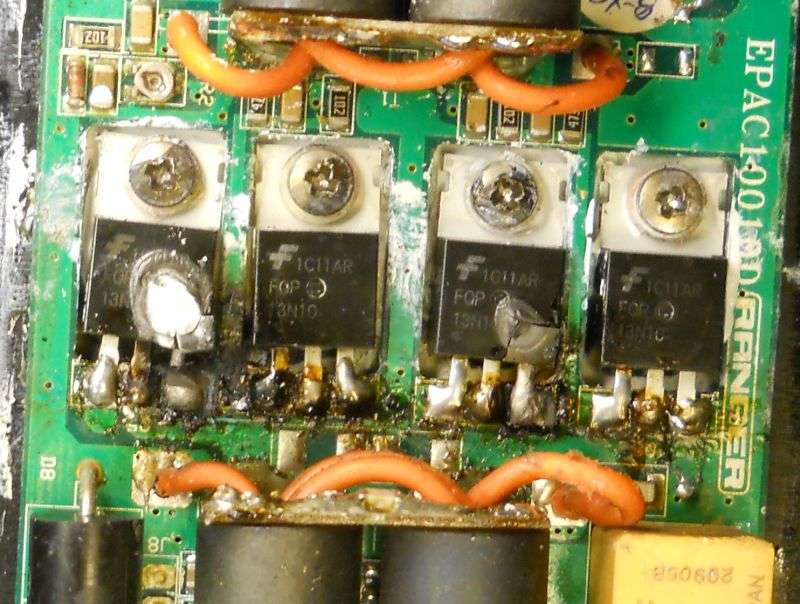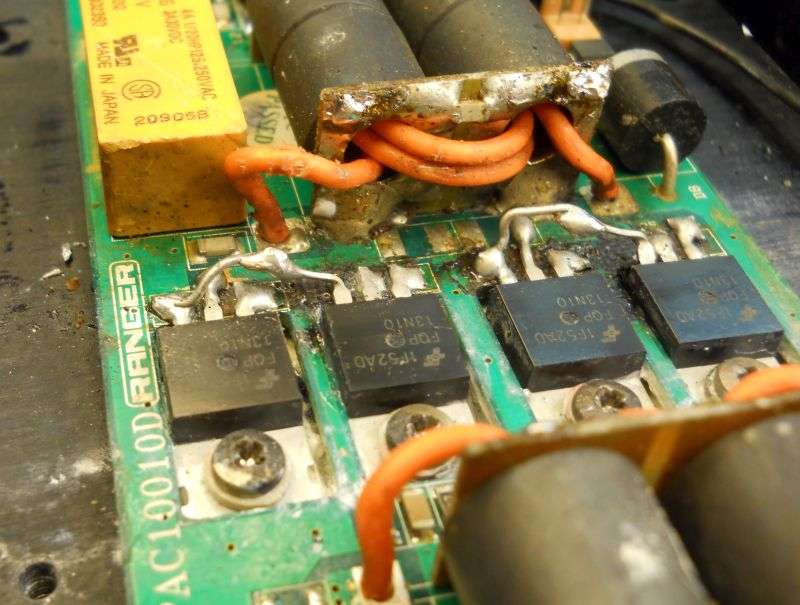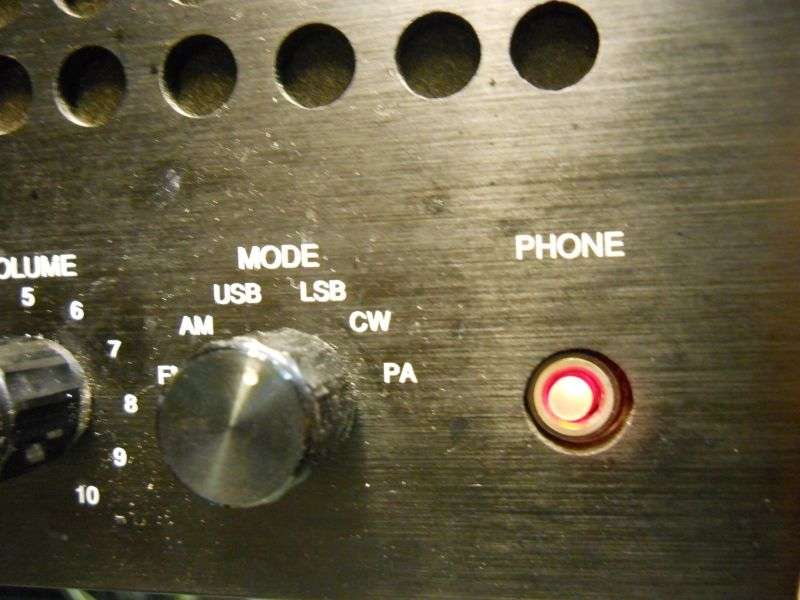Oh yes, they can "get down" with a dead short, I've seen the demonstration videos!Leapfrog 3:1 is nothing LDMOS can take anywhere from 68:1 to infinite and that is at all phase angles.
You are using an out of date browser. It may not display this or other websites correctly.
You should upgrade or use an alternative browser.
You should upgrade or use an alternative browser.
-
You can now help support WorldwideDX when you shop on Amazon at no additional cost to you! Simply follow this Shop on Amazon link first and a portion of any purchase is sent to WorldwideDX to help with site costs.
-
A Winner has been selected for the 2025 Radioddity Cyber Monday giveaway! Click Here to see who won!
ERF7530 equivalent replacement?
- Thread starter k2cb
- Start date
Well fast forward a year and I am softening my stance on non-rf-specific mosfets in rf applications. I think I just hated how people only blow sunshine up peoples rears when talking about mosfets in place of bjt's in rf production. So I got my panties in a twist over it! I really do not like it when people only focus on the Pro's and ignore all of the con's!
I am not a Salmon or Trout so swimming upstream is tiresome! LOL
I think that a lot of problems with Mosfets in radio's as finals has to do with SWR's. Most of these fets do not like anything over 1.2:1. When you add in the fact that some of the amps these are used in have a really poor impedance match it is like a perfect storm to destroy fets! LOL
I am not a Salmon or Trout so swimming upstream is tiresome! LOL
I think that a lot of problems with Mosfets in radio's as finals has to do with SWR's. Most of these fets do not like anything over 1.2:1. When you add in the fact that some of the amps these are used in have a really poor impedance match it is like a perfect storm to destroy fets! LOL
Do not quote me ob this since I am going from memory but I think Toshiba 2SC2879's where good for 25:1 or 30:1 mismatch at all phase angle when you look at non-rf-specific fet's they are a joke by comparison. That is why one reason why people are flowing mosfets in radio's and amps left to right and center. The other massive issue is impedance mismatch.Oh yes, they can "get down" with a dead short, I've seen the demonstration videos!
If you buy FQP13N10's 100 at a time from Mouser you can get them for $.453 cents per. You would have to blow up over 120 of them before you cost yourself the price of a single Toshiba 2SC2879.
The MOSFETs are cheap, but the circuit boards are not. And they tend to sustain as much damage as the replaceable parts.
An amplifier with one transistor can be protected okay. A fuse that trips out with only 150 percent of safe current for that one transistor will protect most of the other stuff in the circuit.
An amplifier with four transistors can't be protected for any less than a four-to-one overload factor. What's a safe fuse for just one transistor must now be four times that size so you'll have enough current to run four transistors. The first transistor to break down must draw four times that much to trip the fuse.
Four times that original 150 percent factor becomes a six-to-one actual overload on the first transistor that goes bad.

This level of overload tends to damage your printed circuit board. The heat from a transistor that's melting down causes damage to pcb traces as well.
We were able to "fly" component leads to take the place of burned foil traces on this specimen.

Won't be able to do that forever. He'll run out of traces if he blows it up again.
Had the idea to put a red LED peeking out of the headphone jack as a reminder that the suicide switch is on the "Sooner" setting when the switch is flipped up.

What the world needs is a good velcro-style pc board for linears. No soldering needed, just "rip/zip" when you blow it up and bolt in new transistors.
Once every few keys of the mike.
73
An amplifier with one transistor can be protected okay. A fuse that trips out with only 150 percent of safe current for that one transistor will protect most of the other stuff in the circuit.
An amplifier with four transistors can't be protected for any less than a four-to-one overload factor. What's a safe fuse for just one transistor must now be four times that size so you'll have enough current to run four transistors. The first transistor to break down must draw four times that much to trip the fuse.
Four times that original 150 percent factor becomes a six-to-one actual overload on the first transistor that goes bad.

This level of overload tends to damage your printed circuit board. The heat from a transistor that's melting down causes damage to pcb traces as well.
We were able to "fly" component leads to take the place of burned foil traces on this specimen.

Won't be able to do that forever. He'll run out of traces if he blows it up again.
Had the idea to put a red LED peeking out of the headphone jack as a reminder that the suicide switch is on the "Sooner" setting when the switch is flipped up.

What the world needs is a good velcro-style pc board for linears. No soldering needed, just "rip/zip" when you blow it up and bolt in new transistors.
Once every few keys of the mike.
73
That circuit board is nasty. It should have been cleaned a long time ago. Flux becomes conductive and corrosive over time. That will cause more failures in the future.
Good to know; thanks. I've recently discovered from a recent video that most adhesives (doesn't have to be the adhesive on old Uniden chassis) can go conductive really quick. Doesn't take a decades. Seems that planned obsolescence is getting a boost. I'm a comparative noob to all this this stuff; so pardon my surprise.That circuit board is nasty. It should have been cleaned a long time ago. Flux becomes conductive and corrosive over time. That will cause more failures in the future.
Last edited:
The black carbon left when the epoxy laminate burns is in fact conductive. We routinely grind it away with a carbide burr on a Dremel tool.
It's a bigger deal with high voltages, but can still cause trouble at 12 Volts.
73
It's a bigger deal with high voltages, but can still cause trouble at 12 Volts.
73
So true I did not even think about that! It is obvious once you point it out! Like I said I will play with them for myself but I would never want to build and sell a product with them by choice. Asking people to keep SWR's to crazy insane 1.2:1 or else is just insane! I would have to find an affordable mosfet that was not so sensitive to swr issues. Even if it was $5-$10 each that would still be dirt cheap compared to the price of Toshiba's!The MOSFETs are cheap, but the circuit boards are not. And they tend to sustain as much damage as the replaceable parts.
An amplifier with one transistor can be protected okay. A fuse that trips out with only 150 percent of safe current for that one transistor will protect most of the other stuff in the circuit.
An amplifier with four transistors can't be protected for any less than a four-to-one overload factor. What's a safe fuse for just one transistor must now be four times that size so you'll have enough current to run four transistors. The first transistor to break down must draw four times that much to trip the fuse.
Four times that original 150 percent factor becomes a six-to-one actual overload on the first transistor that goes bad.

This level of overload tends to damage your printed circuit board. The heat from a transistor that's melting down causes damage to pcb traces as well.
We were able to "fly" component leads to take the place of burned foil traces on this specimen.

Won't be able to do that forever. He'll run out of traces if he blows it up again.
Had the idea to put a red LED peeking out of the headphone jack as a reminder that the suicide switch is on the "Sooner" setting when the switch is flipped up.

What the world needs is a good velcro-style pc board for linears. No soldering needed, just "rip/zip" when you blow it up and bolt in new transistors.
Once every few keys of the mike.
73
Proper design will prevent impedance mismatch damage. You should always tune your antennas with low power in the middle of your operating frequency, because you are tuning to the frequency not the power level.
If your antenna is tuned for 4 watts it is tuned for four hundred watts.
If your antenna is tuned for 4 watts it is tuned for four hundred watts.
ERF7530 Replacements are the new ERF9530 .......
Datasheet provided by Palomar .....
http://www.servicedocs.com/ARTIKELEN/50700284730001.pdf
Datasheet provided by Palomar .....
http://www.servicedocs.com/ARTIKELEN/50700284730001.pdf
In high voltage circuits it will arc or flash over and catch fire. Not a problem with 12 volts though.On a burned board; doesn't the carbon of the burned fiberglass board also conduct as well?
Seen a viddy of that one happening - too
dxChat
- No one is chatting at the moment.
-
dxBot:brandon7861 has left the room.
-
-
-
-
@ boniface95:Hi there, I just posted this question, if anyone has time to check it out, i'd really appreciate some feedback. https://www.worldwidedx.com/threads...-radio-transmitters-in-the-same-space.270736/
